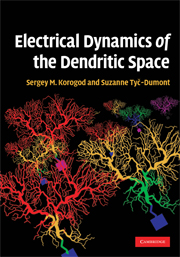Book contents
- Frontmatter
- Contents
- Preface
- 1 Definition of the neuron
- 2 3D geometry of dendritic arborizations
- 3 Basics in bioelectricity
- 4 Cable theory and dendrites
- 5 Voltage transfer over dendrites
- 6 Current transfer over dendrites
- 7 Electrical structure of an artificial dendritic path
- 8 Electrical structure of a bifurcation
- 9 Geography of the dendritic space
- 10 Electrical structures of biological dendrites
- 11 Electrical structure of the whole arborization
- 12 Electrical structures in 3D dendritic space
- 13 Dendritic space as a coder of the temporal output patterns
- 14 Concluding remarks
- Index
- References
3 - Basics in bioelectricity
Published online by Cambridge University Press: 03 May 2010
- Frontmatter
- Contents
- Preface
- 1 Definition of the neuron
- 2 3D geometry of dendritic arborizations
- 3 Basics in bioelectricity
- 4 Cable theory and dendrites
- 5 Voltage transfer over dendrites
- 6 Current transfer over dendrites
- 7 Electrical structure of an artificial dendritic path
- 8 Electrical structure of a bifurcation
- 9 Geography of the dendritic space
- 10 Electrical structures of biological dendrites
- 11 Electrical structure of the whole arborization
- 12 Electrical structures in 3D dendritic space
- 13 Dendritic space as a coder of the temporal output patterns
- 14 Concluding remarks
- Index
- References
Summary
There is no bioelectricity without space. To produce an electric field, electrical charges must be separated in space. The distance separating the charge carriers – the ions – on the neuronal membrane ranges between 6 and 10 nanometres. The charges are separated by the action of non-electrical forces that must be organized in space. Pump molecules embedded in the membrane operate by chemical binding and unbinding of the ions on the opposite sites of the membrane. The shape of the cell membrane together with the membrane material determine the membrane capacitance.
Ions as carriers of current
In neurons the currents are carried by ions flowing in the conductive intra- and extracellular media, the cytoplasm and cerebro-spinal fluid. The intra- and extra-cellular media are conductors of the second class, the electrolytes. The ions are elementary species of both charge and substance. Therefore, two driving forces move them: electrical and non-electrical, diffusive or chemical. Both types of forces occur due to special properties of the neuronal membrane separating the intracellular solution from the extracellular one. Electrical forces originate from the voltage difference (gradient). Diffusive forces are due to gradient of ion concentration. Ions change their spatial location also as a result of chemical reactions, e.g. with intracellular or membrane molecules. Main ion species carrying currents are sodium (Na+), potassium (K+), calcium (Ca2+) and chloride (Cl−). Each species has different concentrations inside and outside the cell.
- Type
- Chapter
- Information
- Electrical Dynamics of the Dendritic Space , pp. 37 - 46Publisher: Cambridge University PressPrint publication year: 2009



